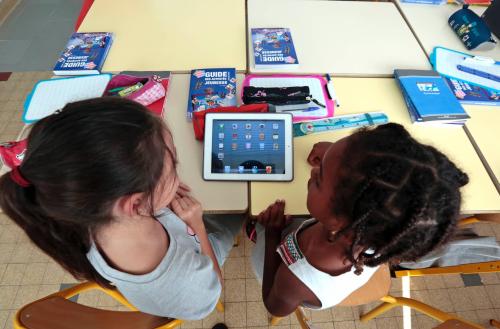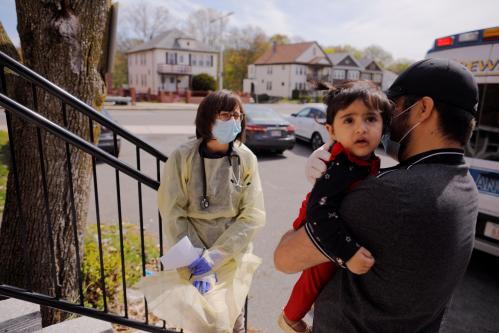When children start school, they do so with differing experiences, influenced by their early home environments, parenting, care arrangements, and neighborhoods. The result is widely varying levels of school readiness by age five. 1 These differences in school readiness have led many to conclude that providing children with a high-quality pre-K experience would help them do better in school and reduce current educational and income disparities.
The Biden Administration included a proposal for universal pre-K in the Build Back Better (BBB) bill.2 Although the bill was not enacted, the issue remains important for both states and the federal government. Forty-six states now have pre-K programs, although they vary in what they provide (Potts, 2023). Additionally, pre-K enrollment and access is limited among lower-income families. In 2019, 42% of three- and four-year-old’s in families earning under 185% of the poverty threshold were enrolled in pre-K, as compared to 54% of children in higher-income families (Irwin et al., 2021).
But exactly how large are disparities in school readiness, what’s driving them, and how much difference do they make for children’s long-term success? Does access to pre-K lead to greater success in school and help to close existing disparities that often persist until later in a child’s life? Should programs be universal or targeted to a specific disadvantaged subgroup? And what do we know about how to make programs more effective?
In this paper, we review the major findings from the existing pre-K literature evaluating the effectiveness of such programs. Although researchers have found sizeable impacts of pre-K programs based on studies of small samples of very disadvantaged children born over 50 years ago, with some exceptions, they have often not found such effects when evaluating scaled-up, public programs serving today’s children. Additionally, most studies of recent cohorts of children have only been able to look at the short-run effects of the programs. What we would like to explore is both the short and the longer-term effects of pre-K in a scaled-up public program serving today’s children.
One common observation is that pre-K programs are very heterogeneous and that quality matters. It has been harder to say what we mean by “quality,” but without attention to what goes on in the classroom and to the early-care work force, an expansion of pre-K could fail to produce any meaningful results. Another issue is targeting. Most of the existing research finds that pre-K programs benefit disadvantaged children more than the advantaged. But programs that serve low-income children may turn out to be of lower quality than those with universal eligibility and a broader political constituency.
In addition to reviewing the existing literature, we add to it by using longitudinal data from a large-scale microsimulation model to look at current gaps in school readiness by family income, race and ethnicity, and gender. We then show how those school readiness gaps reverberate throughout a child’s educational career, leading to disparate outcomes later in life, and providing some insight into the mechanisms that explain why early interventions may have long-term effects. In brief, we find that:
- Children born to lower-income families (e.g. less than 200% of poverty) are less likely to be school ready. There are large gaps in school readiness by race and ethnicity although these are partially due to the disproportionate number of Black or Hispanic families in poverty.
- Across all racial groups, girls are more likely to be school ready at age five than boys. These gender gaps are most evident for children from low-income families. By the time they are adults, whatever influence the gender gap had at younger ages seems to disappear with women falling behind men on various measures of economic (although not educational) success.
- Children who are school ready at age five are more likely than other children to be successful in school through adolescence, to graduate from high school, to receive a BA degree, and to have higher lifetime earnings. However, some of these effects occur because these children come from more advantaged backgrounds to begin with and cannot be attributed to their school readiness alone.
- After adjusting for these so-called “selection effects,” we still find that school readiness matters for long-term outcomes, although to a much lesser degree after we control for as many confounding variables as the data will allow.
- We then draw on the existing literature on state-based programs to make assumptions about how much difference a pre-K program might make in addressing the lack of school readiness at age five. We simulate how these assumed effects at age five would translate into longer-term effects for the children who received the program compared to those who did not. We find that a universal pre-K program for all children might:
- Increase BA attainment by 1.1 percentage points or 4.3%.
- Increase annual earnings at age 30 by $962 or 2.8%.
- Increase lifetime earnings by $15,756 or 2.4%.
- We also simulate the effects of a targeted program that would serve lower-income (below 200% FPL) children only. The absolute effects on BA attainment and earnings are just a bit higher than those for all children, but the relative increases are much higher for poorer children due to this group’s lower baseline education and earnings. Specifically, we find that a targeted pre-K program for low-income children might:
- Increase BA attainment by 1.3 percentage points or 8.2%.
- Increase annual earnings at age 30 by $963 or 3.6%.
- Increase lifetime earnings by $16,327 or 3.1%.
- In addition, because more advantaged children are excluded in a targeted program, their education and earnings are not affected with the result that education and income disparities between groups are further reduced. A targeted program does more to reduce racial disparities for similar reasons.
- While girls tend to be more school ready than boys at age five, the impact of a pre-K program for girls vs. boys depends on the metric being studied. In the case of earnings at age 30, the intervention favors girls. For lifetime earnings, it favors boys. But this is likely because adult women spend more time out of the labor force and if we had a measure of parenting skills to add to earnings at age 30, it might still favor girls.
- Finally, we examined which measures of school readiness matter most for later success and find that cognitive abilities are more important than behavioral measures, and that math skills are much more important than reading.
No one study can provide a full picture of the effects of pre-K, and we urge caution in relying on any one estimate, including ours, to answer the questions posed above. The research community has rightly emphasized the importance of identifying the causal effects of any intervention. The policy and practice communities are more focused on the variation in the quality of existing programs. The two together may explain why estimates of the impacts of pre-K vary. Pre-K in 2020 has different effects than pre-K in 1960. Pre-K in Boston has different effects than pre-K in Tennessee. Not only do programs vary, but so do the children who are enrolled, and the alternative care arrangements they would have experienced in the absence of a formal pre-K program. The limitations of the data and analysis in any one study and the heterogeneity of the programs being evaluated requires some humility in coming to firm conclusions. Nonetheless, in our conclusions, we offer our best current judgements about the implications of all of this research for policy.
Click here to read the full report.
The Brookings Institution is financed through the support of a diverse array of foundations, corporations, governments, individuals, as well as an endowment. A list of donors can be found in our annual reports published online here. The findings, interpretations, and conclusions in this report are solely those of its author(s) and are not influenced by any donation.
-
Acknowledgements and disclosures
The authors would like to thank James Sawhill for his excellent analytical help with the Social Genome Model (SGM). We would also like to thank all of our SGM partners at Child Trends and the Urban Institute, especially Kristin Moore and Gregory Acs, for their extensive work with the model and comments on this paper. Additional comments were provided by Lauren Bauer, Bob Greenstein, Harry Holzer, John Sabelhaus, and especially Tara Watson. The paper was fact-checked by Simran Kalkat and edited by Coura Fall.
-
Footnotes
- Throughout this report we use the term “school readiness” as a benchmark for success at the pre-K life stage. The definition of school readiness is that at age five, the child enters school (kindergarten) with the academic preparedness, behavior, and capacity to sustain interpersonal relationships, and physical health that would lead them to thrive.
- The Build Back Better Act invests in securing universal preschool (UPK) for three- and four-year-old’s, which the administration states will help “prepare as many as 6 million children for happier, healthier, and more productive lives.” On November 17, 2021, the Congressional Budget Office estimated that the program would cost over $100 billion over a 10-year budget window (Estimated Budgetary Effects of Title II, Committee on Education and Labor, H.R. 5376, the Build Back Better Act, 2021).








